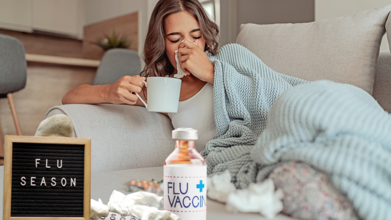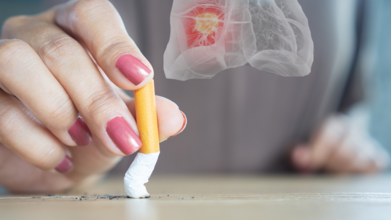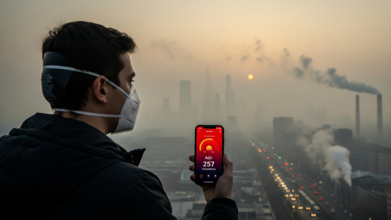- Health Conditions A-Z
- Health & Wellness
- Nutrition
- Fitness
- Health News
- Ayurveda
- Videos
- Medicine A-Z
- Parenting
- Web Stories
NHS Prompts People To Watch Out For This Summer Skin Sign - 'Call Emergency Services Immediately'

(Credit-Canva)
As UK temperatures rise, more and more people are concerned about heat related illnesses and how to ensure they stay safe in this weather. In fact, in June of 2025, the UK National Health Service website had 31,524 visits within 48 hours as they issued a heat-health alert, compared to the 10,000 views they had just days prior. This helped many people be aware of their health and keep safe. However, temperatures are yet to relent, and One must stay careful.
With the UK currently experiencing very high temperatures, it's really important to know the signs of heatstroke, which can be quite dangerous. The NHS is telling people to dial 999 right away if they see a particular, serious symptom on someone's skin. This is a crucial step because heatstroke can be life-threatening if not addressed quickly.
Heatstroke: An Emergency Situation
Heat exhaustion is a milder condition, but it can quickly get much worse and turn into heatstroke if it's not dealt with fast. The NHS explains that if someone has heat exhaustion, they usually won't need emergency medical help as long as they can cool down within about half an hour. However, if that heat exhaustion turns into heatstroke, it's a completely different story – it becomes a real emergency. The health service is very clear: you should "call 999 now if you or someone else has signs of heatstroke." This isn't a suggestion; it's a direct instruction for a serious situation.
Key Heatstroke Symptoms to Watch For
One very important sign to look out for is skin that feels hot to the touch but isn't sweating, and it might look red. It's worth noting that this particular sign can be harder to spot on darker skin tones.
You also need to get emergency help if someone still isn't feeling well after being in a cool place for 30 minutes, having cooling treatments applied, and drinking fluids. Other signs of heatstroke that mean you should call 999 immediately include: an extremely high body temperature; a very fast pulse or heartbeat; breathing that is quick or difficult; feeling confused and having trouble moving in a coordinated way; having a seizure or fit; or passing out (losing consciousness).
If the person becomes unconscious while you're waiting for help to arrive, the NHS advises you to gently roll them onto their side into the recovery position.
Warning Signs of Heat Exhaustion
Before someone gets to the serious stage of heatstroke, there are earlier warning signs of heat exhaustion. Keep an eye out for these:
- Feeling very, very tired.
- Feeling dizzy.
- Having a headache.
- Feeling sick to your stomach or actually vomiting.
- Cramps in your arms, legs, and stomach.
- Sweating a lot, and your skin might look pale and feel clammy, or you might even get a heat rash.
- Your breathing or heartbeat might be fast.
- You'll likely have a high temperature.
- Feeling extremely thirsty.
- Feeling weak.
The NHS points out that these symptoms are generally the same for both adults and children, though children might also become irritable or cranky.
What to Do if Someone Has Symptoms
If you notice someone showing these signs of heat exhaustion, the most important thing is to cool them down right away and get them to drink fluids. The NHS recommends these four essential steps:
- Move them to a cool, shady spot. Get them out of the heat!
- Take off any extra clothing they don't need, like a jacket or thick socks.
- Encourage them to drink a sports drink, a rehydration drink, or just cool water. These drinks help replace lost salts and fluids.
Stay with the person until they start to recover, which should happen within about 30 minutes. However, if they don't get better after following these steps, you might need to call 999 for emergency help.
What Makes Flu Season 2025 Different? Unique Symptoms Of Flu In 2025 And How Long The Infection Lasts

Credits: Canva
The 2025 flu season has turned out to be unlike any other in recent memory. This year, the flu season is marked by record-setting infections, multiple viral peaks, vaccine mismatches, and an overstretched healthcare system.
According to the Centers for Disease Control and Prevention (CDC), this year’s influenza activity is the most intense since the 2009 swine flu pandemic, with over 80 million estimated illnesses and rising. What’s driving this intensity, and what should the public know about prevention and symptom management?
Let’s break down what makes this flu season so severe and what it means for your health.
A Season Like No Other: What Makes 2025 Different?
In most years, flu activity in the U.S. typically follows a predictable pattern, starting in October, peaking between December and February, and fading by April. But the 2024–2025 season has defied that rhythm.
Cases surged past the national baseline in December and then, unexpectedly, peaked again in February, a second wave that blindsided doctors and public health experts.
As of March 2025, the CDC had reported an estimated 37 million influenza infections, 480,000 hospitalizations, and 21,000 deaths. Hospitalizations, in fact, reached their highest levels in 15 years.
One key driver? A mismatch between circulating flu strains and this year’s vaccine. The dominant strains: H1N1 and H3N2, accounted for more than 99% of cases.
H3N2, in particular, is known for mutating quickly and evading immune responses, and only about half of circulating H3N2 samples matched well with vaccine antibodies, according to CDC surveillance data.
Post-Pandemic Immune Gap
Another reason this year’s flu is hitting so hard: our immune systems are still catching up.
During the height of the COVID-19 pandemic, widespread masking, social distancing, and school closures suppressed not just SARS-CoV-2 but also seasonal flu and other common respiratory viruses. While that helped in the short term, it reduced community-level immunity over time, especially among children, who typically build natural resistance through repeated exposures.
“Young children who were toddlers or preschoolers during the pandemic missed early exposures to flu viruses,” explained experts at the nonprofit group Families Fighting Flu. “Now they’re in school, more socially active, and more vulnerable.”
The CDC reported a troubling spike in pediatric flu deaths this season with 216 fatalities, making it the deadliest flu season for children outside of a pandemic year. Neurological complications such as seizures and hallucinations also rose among young patients.
A Shift in Viral Dominance
Another unusual trend: COVID-19 has taken a back seat this winter
Unlike previous years when COVID-19 variants dominated respiratory illness charts, flu has surged ahead as the top driver of doctor visits and hospitalizations. This could be due to a shift in viral dominance, changing weather patterns, or differences in immunity buildup. According to the CDC, nearly 8% of all outpatient visits are currently for flu-like symptoms, much higher than what’s typical for this time of year.
Vaccine Fatigue and Gaps in Coverage
Vaccination remains the strongest tool we have to fight influenza, but uptake has been stagnant, or worse, declining, in key groups.
As of April 2025:
- Only 49.2% of children and 46.7% of adults had received the flu vaccine
- Among pregnant women, that number dropped to 38%
- Medicare beneficiaries aged 65+ had just 48.3% coverage
- And overall, nearly 9.2 million fewer doses were administered compared to the pre-pandemic 2019–2020 season
Barriers like vaccine hesitancy, misinformation, racial and ethnic disparities in healthcare access, and fewer flu shot clinics in rural areas continue to widen the gap.
What Are the Symptoms in 2025?
The 2025 flu has shown typical but often more intense symptoms than in previous years. Here’s what to look out for:
- Sudden onset fever
- Severe body aches and chills
- Sore throat and persistent cough
- Nasal congestion
- Diarrhea and vomiting (more frequent in children)
- Extreme fatigue
- Headache
- In some children, neurological symptoms like confusion or seizures
These symptoms may overlap with COVID-19 or RSV, but tend to come on faster and hit harder in flu cases this season.
How Long Do Symptoms Last?
For most healthy people, flu symptoms begin 1 to 4 days after exposure and typically last about 5 to 7 days. However, fatigue and cough may linger for up to two weeks.
You’re considered most contagious in the first 3 to 4 days after symptoms start but can continue to spread the virus up to a week later. The CDC recommends staying home until you’ve been fever-free for at least 24 hours without medication.
Vaccinated individuals may experience milder or shorter symptoms, but those with underlying conditions, young children, and older adults may have longer recoveries and higher risk of complications.
Can the Flu Cause Serious Health Problems?
Yes, especially in people with weakened immune systems, chronic illnesses, or no prior flu immunity.
Possible complications include:
- Pneumonia
- Ear and sinus infections
- Exacerbation of asthma or heart disease
- Life-threatening conditions requiring ICU care
This is why experts stress that prevention remains the best medicine.
How to Protect Yourself and Your Family
Here’s how to lower your risk during the remainder of the 2025 season:
- Get vaccinated, even now. It may still protect against circulating strains
- Wash your hands often with soap and water
- Avoid touching your face in public settings
- Cover your mouth and nose when coughing or sneezing
- Stay home if you’re unwell to prevent spreading the virus
'It’s Not Too Late': Even After A Lung Cancer Diagnosis, This One Habit Change Can Save Your Life

Credits: Canva
A lung cancer diagnosis shatters worlds. It thrusts patients into a whirlwind of fear, confusion, and uncertainty. What now? How will I cope? Is this the end? These questions are inevitable and urgent. Yet, amid the anxiety, many patients harbor a dangerous belief: that if cancer has taken hold, quitting smoking is pointless.
It's not just a myth, it’s dangerous. Newer studies show quitting smoking even after a cancer diagnosis can significantly improve survival, make treatments more effective, and alleviate symptoms. In other words: even after cancer strikes, letting go of cigarettes can save your life.
In many small towns across India, where awareness about cancer and tobacco risks is limited, patients often continue to smoke despite their diagnosis. “Some feel it is too late to stop. Others are too addicted or too hopeless to try,” says Dr. Ruchi Singh, HOD & Senior Consultant of Radiation Oncology at Asian Hospital. This is the kind of thinking that kills from the inside out.
The reality is the opposite. Dr. Singh emphasizes, “We try to explain … it is never too late. If they stop smoking, even after the cancer has started, the treatment becomes more effective. It is one of the most important things they can do for themselves.”
Every cigarette after diagnosis undermines treatment, weakens the body, and shortens survival. But should someone quit even late into their cancer journey their lungs begin to heal, treatments work better, and recurrence becomes less likely.
How Does Quitting Smoking Extends or Saves Lives?
Global research aligns with Dr. Singh’s clinical advise, a study by IARC and Russian oncologists followed 517 lung cancer patients who smoked at diagnosis. Those who quit within three months lived 22 months longer on average and had 33% lower mortality risk and 30% lower disease progression, regardless of stage or smoking intensity.
The Prospective cohort of the Annals of Internal Medicine confirmed quitting after diagnosis yields meaningful survival benefits.
MUSC Hollings Cancer Center. A Harvard study of nearly 5,600 non-small cell lung cancer (NSCLC) patients found former smokers lived longer than current smokers, suggesting even pre-diagnosis quitting increases survival. Additional studies show quitting at or around diagnosis reduces mortality significantly and improves outcomes across all stages of NSCLC.
Smoking cessation isn’t just beneficial—it is one of the most powerful lifesaving interventions for lung cancer patients.
People tend to discount vaccines or preventive care because success makes the threat invisible. Lung cancer prevention has been a public health battle for decades. Policymakers and physicians worked to reduce smoking rates, and incidence fell. But once a cancer diagnosis arrives, all remission plans depend on a foundation of good habits—like quitting tobacco.
Tobacco smoke introduces toxins, weakens immune function, and diminishes treatment outcomes. Continuing to smoke after diagnosis:
- Lowers treatment efficacy
- Increases post-surgery complications
- Heightens the risk of recurrence or second primary cancers
- Shortens survival significantly
- Quitting reverses much of that risk—even post-diagnosis.
How to Quit Smoking After Lung Cancer Diagnosis?
Treatment regimens already overwhelm patients. Quitting smoking under stress and physical duress is tough—but not impossible. With the right support, patients dramatically increase their success odds. Here’s a compassionate roadmap:
- Set your quit date now, delay weakens motivation and clarity.
- Seek medical support, consult your oncologist or a specialist in Siliguri. Therapy, nicotine replacements, or counseling can double your quitting success.
- Lean on loved ones, share your commitment and ask for accountability.
- Identify your triggers- stress, discomfort, or routine can push you back. Replace smoking with walking, meditation, or tea.
- Shift lifestyle habits and replace “smoke with morning coffee” rituals with alternative rituals—like stretching or herbal tea.
- Build habits that support health- hydration, nutritious food, gentle movement and joy—these restore lung health and resilience.
Indeed, about 36% of tobacco-linked lung cancer patients manage to quit after diagnosis. Those are lives reclaimed.
Lung cancer still has a stigma. Many see it as self-inflicted. That stigma often delays help—including quitting support. But as Dr. Singh reminds us: “People think cancer means a death sentence. But many cases are treatable, especially if caught early. If someone quits smoking, we see real improvement such as better breathing, better recovery after surgery, and fewer chances of the cancer coming back.”
For patients, oncology teams, and families, smoking cessation after diagnosis isn’t optional—it’s urgent evidence-backed medicine.
A lung cancer diagnosis changes everything, but it does not define what comes next. Quitting smoking—even when the disease has already appeared—creates space for healing, response, and survival. It says, “I’m still here. I’m still fighting."
If you or someone you love is facing lung cancer- quit, today. It doesn’t erase the past—but it can extend the future. Numbers don’t lie: treatment plus quitting smoking can give us 22 more months, more energy, more peace, and a higher chance of beating this disease. Quitting is more than choice. It’s courage. And it is always worth it.
World Lung Cancer Day 2025: Is Pollution The New Cigarette For Your Lungs? 5 Habits To Save Your Breath

Credits: Health and me
When you stop for a moment, take a deep breath. How clean do you think is the air you just inhaled? If you live in a city or anywhere near heavy traffic, construction zones, or industrial areas chances are that breath carried more than just oxygen. Increasingly, health experts are raising a red flag: air pollution is becoming just as dangerous for your lungs as cigarette smoke. Unlike a lit cigarette, you can’t see it or smell it as easily, but the damage? It’s happening all the same—quietly, gradually, and across the globe.
On World Lung Cancer Day, it’s time to stop treating pollution as a background inconvenience and start seeing it for what it is: a major, modifiable threat to lung health.
We’ve long understood smoking as the leading cause of lung cancer, but the health narrative is shifting. Air pollution is catching up—and fast. According to the World Health Organization, over 7 million people die each year from air pollution, with billions more living with compromised respiratory health. Dr. Tedros Adhanom Ghebreyesus, Director-General of WHO, didn’t mince words back in 2018 when he said, “Air pollution is the new tobacco.”
The culprits are tiny, invisible particles like PM2.5 and PM10, nitrogen dioxide from vehicles, and toxins from burning biomass or fossil fuels. These pollutants don’t just irritate the lungs—they penetrate deep into lung tissue, triggering inflammation, reducing immune clearance, and increasing the risk of chronic respiratory illnesses and cancer. As the air gets dirtier, lung cancer in non-smokers—especially women and young adults—is on the rise.
Is Air Pollution Is the New Smoking?
We are already witnessing the consequences of environmental neglect warns Dr. Sachin Trivedi, Director of Medical Oncology at HCG ICS Khubchandani Cancer Centre, further adding, "Cigarette smoking has been known to be the major cause of lung cancer over the past decades. But there is a more recent and equally threatening danger that is on the rise: air pollution."
Dr. Trivedi highlights that a significant number of lung cancer diagnoses are now occurring in non-smokers, suggesting a stronger role for environmental pollutants. From vehicle emissions and industrial fumes to household fuel burning, the sources of this silent threat are everywhere. These pollutants infiltrate deep into the lungs, sparking chronic inflammation, oxidative stress, DNA damage, and even malignant mutations.
Why Lung Damage Due To Pollution Doesn’t Show Symptoms?
Even more concerning, these changes often don’t produce symptoms until the disease is advanced. Which is why early detection, lifestyle awareness, and pollution avoidance are critical. Dr. Trivedi urges individuals to recognize and act on subtle warning signs like chronic cough, shortness of breath, or unexplained weight loss, especially among non-smokers who may not suspect lung cancer.
5 Lung-Saving Habits You Can Practice Daily
Despite the scale of the problem, Dr. Trivedi emphasizes that it’s possible to shield your lungs through smart, consistent habits:
1. Wear a Protective Mask Outdoors
Especially in high-traffic or industrial areas, an N95 mask can block harmful particles like PM2.5. It’s a frontline defense your lungs will thank you for.
2. Maintain Clean Indoor Air
Ventilation is key. Use exhaust fans in kitchens, avoid indoor smoking, and install HEPA-filter air purifiers in high-pollution zones. Urban homes need this extra layer of air hygiene.
3. Limit Outdoor Time on High AQI Days
Track air quality through reliable apps. Skip rush hour outings and outdoor workouts when air quality is poor. Exposure control is protection.
4. Eat an Antioxidant-Rich, Lung-Friendly Diet
What you eat matters. A diet high in vitamins A, C, and E from foods like berries, citrus fruits, broccoli, and nuts can counter oxidative lung damage. Turmeric and green tea also offer anti-inflammatory benefits.
5. Don’t Dismiss Early Symptoms
A persistent cough or breathlessness isn’t always a passing cold. Get medical attention early—especially if you're a non-smoker experiencing unusual respiratory symptoms.
Dr. Devendra Parikh, Consultant in Surgical Oncology at HCG Aastha Cancer Centre, adds in a perspective, "Chronic polluted air harms our lungs just as smoking does: it silently, over time, injures delicate tissue and raises cancer risk. He stresses that fine particles from cooking smoke, traffic fumes, or even poorly ventilated homes carry microscopic toxins that inflame lung tissue and trigger genetic changes." He further shares more ways in which you can protect yourself
- Checking your local AQI each morning helps you make smarter decisions. When air quality dips, stay indoors and keep windows shut.
- These devices capture up to 99.97% of fine particles, drastically improving indoor air. Even running a unit for a few hours can ease respiratory strain.
- A proper N95 or KN95 mask creates a secure barrier against inhaling toxic particles. It’s essential during commutes or outdoor errands on high-smog days.
- Simple breathwork techniques or pranayama for five minutes daily can help clear the lungs and improve capacity.
- For those over 50 or with occupational exposure, low-dose CT scans can detect early signs of lung cancer—even before symptoms begin. Early action saves lives.
You can’t filter the world. But you can control your exposure, build resilient habits, and stay alert to what your lungs are telling you. The new reality is this: pollution is the new cigarette, and we can no longer afford to breathe without awareness. On World Lung Cancer Day and beyond—your breath is worth protecting. In cities where clean air isn’t guaranteed, your daily choices are your lungs’ best defense.
Pollution may feel as unavoidable as city noise, but it doesn’t have to be as destructive. By weaving these habits into your daily life, you give your lungs the best chance to clear toxins, reduce inflammation, and ward off the long-term threat of lung cancer.
© 2024 Bennett, Coleman & Company Limited

